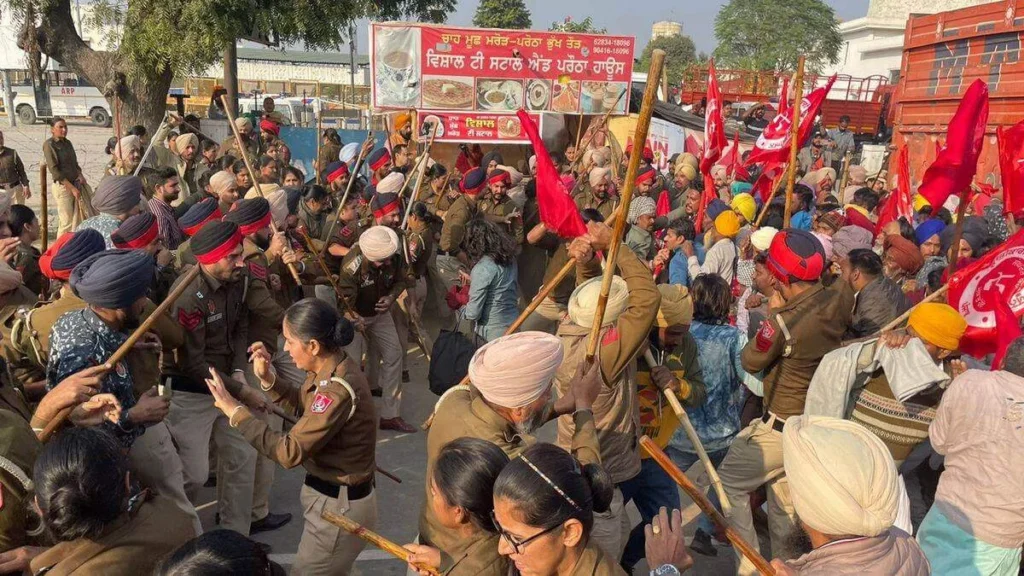Introduction
The Faridkot protest took a violent turn when police officers were attacked with stones, leading to 38 arrests. The incident unfolded in Chandbhan village, where over 100 residents had blocked a road in protest over local public works issues. According to police reports, village sarpanch Amandeep Kaur and her husband, Kuldeep Singh, were leading the demonstration. Authorities intervened to clear the roadblock, but tensions escalated, resulting in injuries and property damage. This article delves into the reasons behind the protest, police actions, and the legal consequences faced by the accused, shedding light on how similar incidents can be prevented in the future.
Why Did the Protest Turn Violent?
The protest began as a demonstration against unresolved public works issues in Chandbhan village. However, when a police team arrived to disperse the crowd, tensions escalated. According to the First Information Report (FIR), the protesters, allegedly instigated by Amandeep Kaur, attacked police personnel with stones, injuring multiple officers and damaging police vehicles. Eyewitnesses report that the situation worsened rapidly as arguments between police officers and protesters turned aggressive.
Key Factors Leading to Violence
- Roadblock Dispute: Protesters refused to clear the road despite police intervention, causing major traffic disruptions.
- Stone Pelting: Police reported that officers were cornered and attacked, making it difficult for them to control the situation peacefully.
- Property Damage: Vehicles belonging to media personnel and private individuals were vandalized, raising concerns over press freedom and civilian safety.
- Attempted Weapon Snatching: Protesters allegedly tried to seize weapons from law enforcement officials, intensifying the chaos and prompting an immediate crackdown.
- Communication Breakdown: Some local leaders and authorities were reportedly absent, leading to a lack of clear communication and conflict resolution strategies.
Police Response and Arrests
Following the attack, Superintendent of Police (SP) Jasmeet Singh confirmed that a case had been registered at Jaitu police station based on the statement of ASI Nachattar Singh, who was present at the scene. The police have arrested 38 individuals so far and are working to identify other accused persons. Authorities stated that additional arrests may follow as investigations continue and more video footage is reviewed.
Legal Actions Taken
- Case registered under multiple sections of the Bharatiya Nyaya Sanhita (BNS).
- 41 named individuals and additional unidentified persons included in the case.
- Ongoing investigation to track down more culprits and analyze their roles in the violence.
- Increased security measures implemented to ensure similar situations do not arise in the future.

Security Measures in Chandbhan Village
To prevent further unrest, police forces have been stationed in the village to maintain law and order. Residents have been urged to report any suspicious activities, and a helpline has been set up for concerned citizens to provide information. SP Jasmeet Singh reassured the public that strict action would be taken against those responsible for the violence and emphasized that peaceful protests should not escalate into lawless behavior.
Steps Taken by Authorities
- Additional police patrols deployed to prevent further disturbances.
- Dialogue initiated with community leaders to address grievances and prevent future escalations.
- Public advisory issued encouraging citizens to protest within the legal framework.
Broader Implications
This incident raises important questions about the balance between protest rights and public order. While citizens have the right to voice grievances, such demonstrations must remain peaceful. Experts suggest that better mediation strategies, improved local governance, and community dialogues could help prevent future conflicts. The Faridkot protest serves as a reminder that communication and swift administrative responses are crucial in handling civic issues.
Conclusion
The Faridkot protest that started as a demonstration over public works issues escalated into a violent confrontation, leading to multiple arrests and legal actions. With continued police presence in the village, authorities are determined to ensure stability and prevent further disturbances. This case highlights the need for effective conflict resolution measures and better engagement between authorities and citizens to avoid future clashes. Stay updated for further developments on this case.


